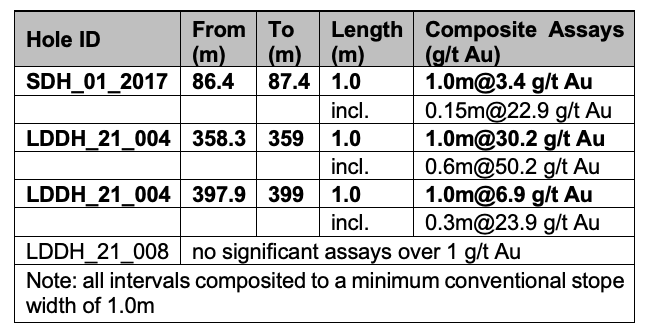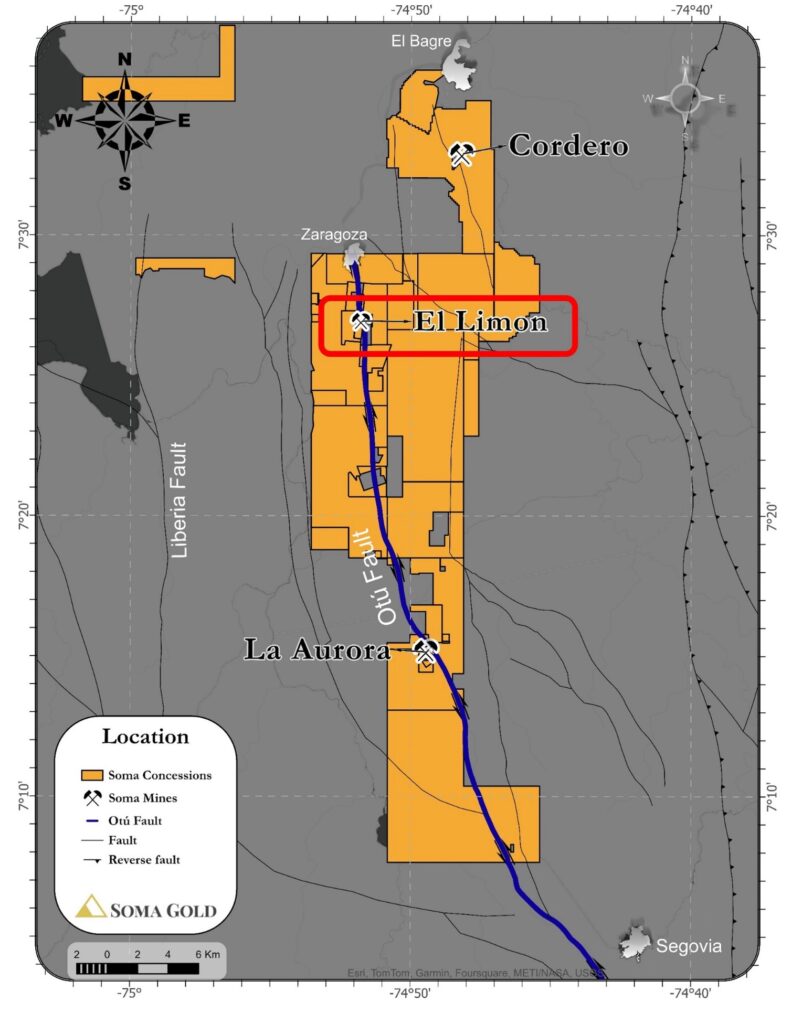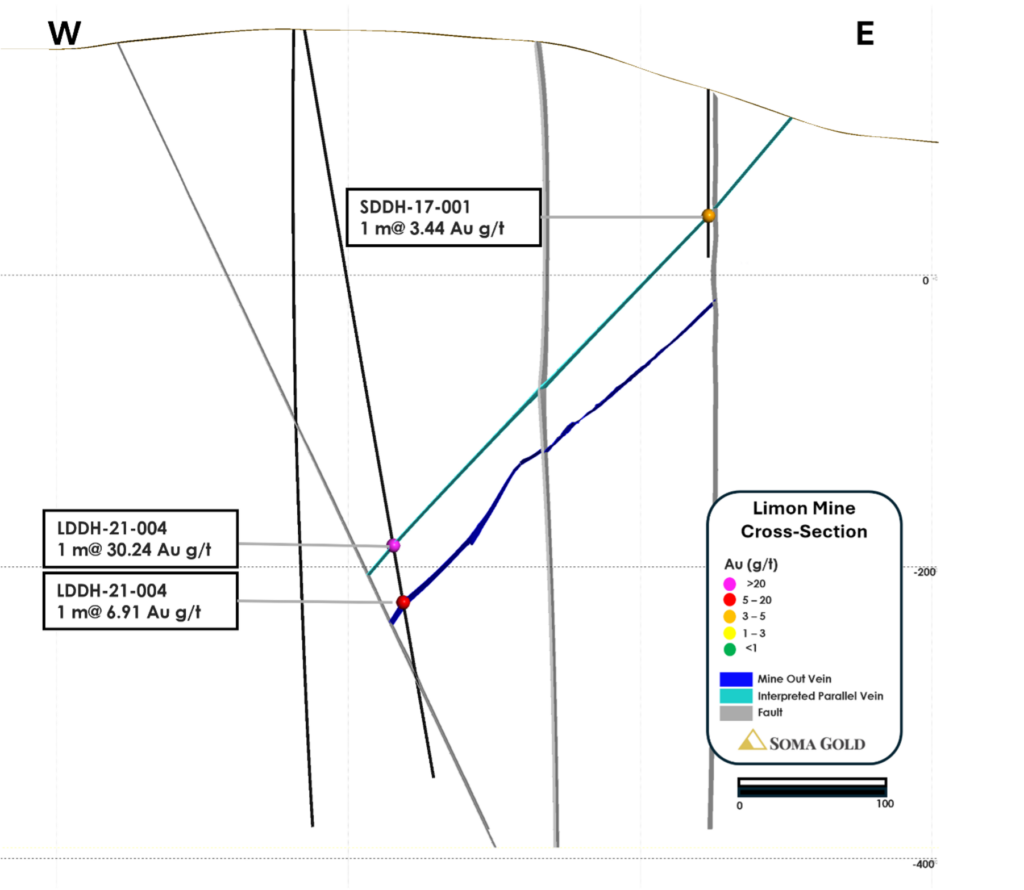September 26, 2024, Vancouver, British Columbia – Soma Gold Corp. (TSXV: SOMA) (WKN: A2P4DU) (OTC: SMAGF) (the “Company” or “Soma”) is pleased to announce that one of the Company’s diamond drill rigs is being mobilized to its El Limon Mine in Zaragoza, Antioquia, Colombia (Figure 1). A review of historical data from the mine and diamond drilling has revealed the presence of high-grade gold intercepts in the hanging wall and footwall of the mine. The 2024 drill program will focus on determining if the vein extends between these drill intercepts. Details of historical results and the 2024 drill targeting model are discussed in this press release.
Key Historical Drill Results:
SDH-01-2017: 1.0m at 3.4 g/t Au incl. 0.15m at 22.9 g/t Au
LDDH-21-004: 1.0m at 30.2 g/t Au incl. 0.6m at 50.4 g/t Au
LDDH-21-004: 1.0m at 6.9 g/t Au incl. 0.3m at 23.0 g/t Au
Geological Overview:
The El Limon Mine is located on the western side of the Otú Fault and is underlain by an extensive domain of high-grade metamorphic gneiss. The gold-bearing quartz veins at the mine are formed as laminated fault-fill veins within a brittle-ductile shear zone, which is interpreted as a higher-order structure related to the Otú Fault. The fault zone strikes north-south and dips moderately to steeply to the west. The fault and associated quartz veins form a series of en echelon segments that step consistently to the left along strike, an orientation pattern observed in other quartz vein systems along the Otú Fault.
To the south of the El Limon Mine, along the same fault zone, are a series of historical informal mines, including the Diamantina Mine, which has identified a north-south striking quartz vein similar to those found at El Limon Mine.
Soma Gold’s Vice President of Exploration, Chris Buchanan, stated, “El Limon is a well-known historical mine in Colombia. Our exploration team is excited to have identified the potential for parallel veins near the current underground workings.”
2024 Drill Program:
The 2024 drilling program will begin with infill drilling down dip of drill hole SHD-17-01. Figure 2 presents a cross-section of El Limon that shows the spatial relationship between the mine and drill intercepts, with a parallel vein interpreted between drill holes SHD-17-01 and LDDH-21-004. The deeper intercept of 23 g/t Au in LDDH-21-004 interpreted to be the down dip extension of the El Limon vein. A deeper drill hole is planned to test this hypothesis later in 2024. No significant gold assays were intercepted in LDDH-21-008. However, the presence of barren quartz veins in the drill hole indicates the structure continues at depth.
Table 1: Composited Au assays from the El Limon Mine

Additionally, Soma is preparing to dewater the deeper levels of the El Limon mine, which will enable detailed geological mapping, systematic sampling, and accurate surveys of the mine’s workings. The exploration team will assess whether ore remains in the historical pillars.
Other Exploration Activities:
Beyond El Limon, Soma continues exploration at the La Aurora and Cordero mines, where surface and underground drilling are ongoing. The exploration team is also evaluating several small-scale mines in the Machuca area and is completing property-wide soil grids in these target areas. As part of its ESG initiatives, Soma continues to engage with local communities around the Machuca property.
The Otú fault system spans over 100 kilometers from Segovia-Remedios in the south to Nechí in the north. Soma holds over 56 kilometers of this fault length, which is known for hosting high-grade gold mineralization. Gold occurs in brittle-ductile to brittle quartz veins formed during late-stage deformation along the Otú Fault. Across the district, the quartz veins display orientation patterns that suggest veins forming in conjugate faults associated with brittle faulting on the Otú Fault. Notable mines along the Otú trend include Segovia-Remedios, La Aurora, El Limon, Le Ye, Los Mangos, and Cordero. The Machuca Property is located along a critical segment of this regional fault structure and contains numerous indications of high-grade gold mineralization.
QA/QC Statement
Drill Core Samples
Soma Gold follows a comprehensive QA/QC program to ensure the reliability of assay data collected from its exploration programs. All samples are sawn, or split, in half, with one half being returned to the core box for storage. The second half-core is placed in a labelled plastic bag with a tag a document and sealed for shipment. Batches of samples are shipped to ALS Colombian (ALS) in Medellin with security tags and documented chain of custody.
Pulps of each sample are prepared in Medellin and shipped to ALS Lima for analysis. All samples are analyzed using the package ME-MS41, an ICP-MS analysis that provides the concentration of 51 elements. Fifty-gram aliquots of each sample are analyzed for gold using a standard fire-assay with an atomic absorption finish. Overlimit samples are subjected to an additional fire-assay with a gravimetric finish to determine the gold concentration.
A comprehensive QA/QC program has been implemented to monitor the reliability of assay data collected during exploration programs. The program includes the regular insertion of certified blanks, duplicates, and certified OREAS standards. Assays of the QA/QC samples are automatically compared to the certified values and standard deviations in the database.
Channel Samples
Channel samples in Colombia are common in underground mining and are typically used for grade control. The channel samples are marked by a spray-painted line. Individual samples along the channel are broken out based on changes in lithology (e.g., quartz vein vs wall rock). A large plastic sheet is laid out below the sample line, and the sample is chipped with a hammer and chisel. The chips are collected by the underlying plastic sheet and transferred to a sample bag.
Prior to December 2023, all the samples were analyzed by the Operadora mine laboratory, and selected samples were submitted to ALS Laboratory for QA/QC analysis. The samples were crushed, split, and pulverized by the Operadora Mine laboratory. Fifty-gram aliquots of each sample are analyzed for gold using a standard fire-assay with a gravimetric finish.
Since 2023, all exploration samples for Soma Gold have been submitted to ALS Lima for analysis, as per the drill core procedures. This is due to renovations of the Operadora mine laboratory for improved health and safety and capacity for increased mine production. Grade control channel samples for the Cordero Mine continue to be processed at the Operadora mine laboratory.
Qualified Person Statement
Mr. Chris Buchanan, P.Geo, is Soma’s Vice-President of Exploration and a Qualified Person as defined by National Instrument 43-101. Mr. Buchanan has reviewed the technical information disclosed in this press release.
Figure 1: Location of the el Limon Mine

Figure 2: Cross-section of the El Limon Mine

ABOUT SOMA GOLD
Soma Gold Corp. (TSXV: SOMA) is a mining company focused on gold production and exploration. The Company owns two adjacent mining properties in Antioquia, Colombia, with a combined milling capacity of 675 tpd. (Permitted for 1,400 tpd). The El Bagre Mill is currently operating and producing. Internally generated funds are being used to finance a regional exploration program.
With a solid commitment to sustainability and community engagement, Soma Gold Corp. is dedicated to achieving excellence in all aspects of its operations.
The Company also owns an exploration property near Tucuma, Para State, Brazil that is currently under option to Ero Copper Corp.
On behalf of the Board of Directors
“C. Geoffrey Hampson”
Chief Executive Officer and President
For further information, please contact Jean Francois Meilleur, telephone: +1-514-951-2730
Neither the TSX Venture Exchange nor its Regulation Services Provider (as that term is defined in the policies of the TSX Venture Exchange) accepts responsibility for the adequacy or accuracy of this release.
All statements, analysis and other information contained in this press release about anticipated future events or results constitute forward-looking statements. Forward-looking statements are often, but not always, identified by the use of words such as “seek”, “anticipate”, “believe”, “plan”, “estimate”, “expect” and “intend” and statements that an event or result “may”, “will”, “should”, “could” or “might” occur or be achieved and other similar expressions. Forward-looking statements are subject to business and economic risks and uncertainties and other factors that could cause actual results of operations to differ materially from those contained in the forward-looking statements. Forward-looking statements are based on estimates and opinions of management at the date the statements are made. The Company does not undertake any obligation to update forward-looking statements even if circumstances or management’s estimates or opinions should change except as required by applicable laws. Investors should not place undue reliance on forward-looking statements.

